…
|
|
||||
What would we know?Underwater seamounts are one to four kilometer high mountains that mostly used to be a volcano. But under a kilometer of water they are hard to see, holy smoke, and we know more about the moon than the bottom of the Mariana, and it’s only 11km “away”. Most of these undersea volcanoes remain uncharted by sonar, and with only one-quarter of the sea floor mapped, it is impossible to know how many exist. Sometimes we only find out when a nuclear submarine runs into one: “It’s just mind boggling.” More than 19,000 undersea volcanoes discoveredNew seamount maps could aid in studies of ecology, plate tectonics, and ocean mixing Paul Voosen, Science In 2005, the nuclear-powered USS San Francisco collided with an underwater volcano, or seamount, at top speed, killing a crew member and injuring most aboard. It happened again in 2021 when the USS Connecticut struck a seamount in the South China Sea, damaging its sonar array. Despite discovering nearly half the known underwater volcanoes just this week, we already knew 30 years ago that they had no effect on the climate. The climate modelers said so. They explained that all the unexplained warming was due to CO2. Hence, ipso ergo absurdum, underwater volcanoes “equals zero”. The Pacific Ocean cycles are the largest driver of climate on Earth, but we *know* as only high priests can, that volcanoes we’ve never studied definitely had no role in it. Thanks to the laws of Government-funded Monopoly Science, the same researchers who would never point that out are now finding reasons that underwater volcanoes might help explain climate change. Now they tell us! Apparently “wake vortices make seamounts the leading contributor to upward ocean mixing, and a central player in climate.” Who knows, they might be right, but where were they twenty years ago when we needed more scientists to point out how inadequate climate models were? 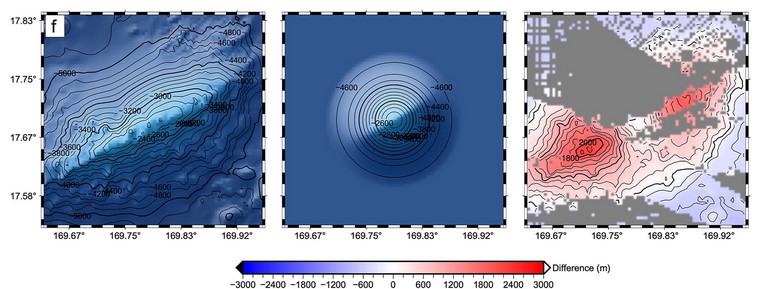 For each seamount example, (left) SRTM15+V2.3 mapped bathymetry, (center) the average Gaussian Model where [omega/h] = 2.4, (right) difference between the average Gaussian model and real data. The gray areas have no soundings. From Science: The “upwelling” was once thought to happen evenly across the ocean, driven by turbulent waves at boundaries between deep ocean layers of different densities. Now, researchers believe it is concentrated at seamounts and ridges. “There’s a zoo of interesting things that happen when you have topography,” says Brian Arbic, a physical oceanographer at the University of Michigan, Ann Arbor. When ocean currents curl around seamounts, they create turbulent “wake vortices” that can provide the energy to push cold water up, says Jonathan Gula, a physical oceanographer at the University of Western Brittany. In unpublished research, Gula and co-authors have found that these wake vortices make seamounts the leading contributor to upward ocean mixing, and a central player in climate. Since the team relied on the old Scripps catalog, not the new one, the effect of the seamounts is probably even larger, Gula adds. Curiously, it was only two months ago we realized in another study that all the benzene and toluene pollution over the vast Southern Ocean was not caused by humans but by phytoplankton blooms. The aerosols produced by microbes can seed clouds, which in turn cool the planet. There’s a 10,000 kilometer ball of magma under the sea floor. We don’t even know all the volcanoes on the crust, let alone the changes in temperature that might drive currents, or influence natural cycles. Even as late as 2018 only 20% of the seafloor had been mapped by ships (Mayer et al., 2018). There’s a lot more to come. 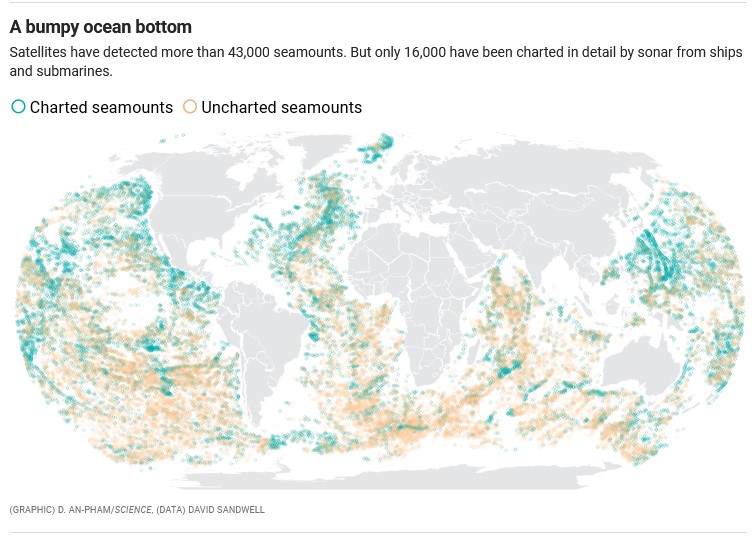 Science: https://www.science.org/content/article/it-s-just-mind-boggling-more-19-000-undersea-volcanoes-discovered People are constantly discovering new volcanoes, like a 3,000m one off Indonesia that no one realized was there til 2010. It turns out the second largest volcano in the solar system is apparently not on Io, but 1,000 miles east of Japan. It’s the size of the British Isles, but who knew? A few years ago a team found 91 new volcanoes under Antarctica. (This is getting serious, someone should talk to the Minister for Lava!) For those who are curious, TechTimes has more details on how they found so many volcanoes. It involves radar satellite data and some Gaussian interpretation: They measured sea surface altitude changes caused by gravitational pull using radar satellite data, a phenomenon known as sea mounding. This method resulted in the discovery of 19,000 previously undiscovered seamounts. With their research, the team found that seamounts have a base-to-height ratio that is linearly related to their height, which means that their shapes are scale invariant. They used a mathematical model called a Gaussian function to calculate this characteristic shape and found that it can be used to accurately estimate the height of small seamounts. h/t Eduard REFERENCE Hillier, J. K., and A. B. Watts (2007), Global distribution of seamounts from ship-track bathymetry data, Geophys. Res. Lett., 34, L13304, doi:10.1029/2007GL029874. Julie Gevorgian et al, Global Distribution and Morphology of Small Seamounts, Earth and Space Science (2023). DOI: 10.1029/2022EA002331 https://www.science.org/doi/epdf/10.1126/science.adi3228 Environmental wokeness has become a liability for investorsThe backlash against ESG has hit bonds, stocks, corporates In a recent survey, half of large investors in North America now admit to worrying that ESG exposes them to legal risk. When companies want to create a Green-Woke project they issue ESG bonds to get loans to build it, but sometime between last year and this year those Bonds have halved. Suddenly companies are not dressing up in the Big Green cloak. That’s $6 billion in ESG investments that didn’t happen. The change in direction has been driven by Florida and Texas and the 19 or more states that have joined them. Even though the $2b in funds Ron De Santis pulled from BlackRock et al last year was a drop in the ocean for a $10 trillion dollar fund, it was the tip of a spear at the heart of the beast. The financial houses and asset managers were using other people’s money to force through political changes those same people didn’t want to vote for. If the crowd followed De Santis the whole game was up. De Santis has just tightened the screws further today: DeSantis Steps Up Attack on ESG as Florida Bars Public InvestmentsBy Marvin G Perez, Bloomberg The new legislation prohibits Florida municipalities from selling bonds tied to ESG projects, as well as imposing restrictions on seeking ESG ratings. In 2022, Florida issuers sold $13 billion of long-term bonds, making it the fourth-largest issuer in the US, behind California, New York and Texas. The law also bars Florida’s public money from being deposited in financial institutions that are deemed to pursue “social, political, or ideological interests” in their investment decisions. Florida had almost $37 billion in state deposits… It’s a phase change in the US with an exodus from ESG Bonds: US ESG Bond Market Chokes on Republican Backlash, Investor AngstBy David Caleb Mutua, Bloomberg Companies sold about $6 billion of bonds last quarter to pay for projects that help the environment, achieve a social goal, or improve their governance, a type of debt known as ESG. That’s down more than 50% from the same time last year, according to data compiled by Bloomberg, which focused on companies outside the financial industry. Many investors are reconsidering their approach to ESG. Almost half of North America’s biggest investors worry that the politics around ESG securities in the US exposes them to legal risks, according to a global survey of firms overseeing $27 trillion published last month. Texas is boycotting funds that boycott fossil fuels:Meanwhile in the US, Texas Comptroller of Public Accounts Glenn Hegar in August 2022 first listed 10 firms and more than 340 individual funds that “boycott energy companies,” a designation that compels state-run entities like pension managers to sell their holdings. “This represents a material shift in the conversation around ESG,” Texas Comptroller Hegar said in an emailed statement. “The shine is wearing off as Americans discover that ESG investments are not only failing to deliver the financial returns that their proponents promised, but also simultaneously distorting the free market incentives that actually might move the needle on some of the policy objectives that ESG investments supposedly support.” So now they scramble to look non-WokeIn March Texas added HSBC to the blacklist. HSBC protested saying that it doesn’t “consider itself to be boycotting the financing of energy companies,” but last year they sacked Stuart Kirk for saying that investors don’t have to worry about “climate risk” years from now. HSBC’s political agenda is obvious. Instead of discussing how they might not know snow, now companies are talking about the risks of “anti-ESG” efforts.
Companies are laying low on ESG as backlash intensifiesEmily Peck, Axios Companies don’t want to talk about their environmental, social and governance goals anymore, experts in ESG and communications tell Axios. State of play: Anti-ESG forces are in full swing this proxy season — the time of year when public companies host their annual meetings, and shareholders vote on a slate of investor proposals.
Wall Street titans confront ESG backlash as new financial riskPatrick Temple-West and Brooke Masters, Financial Times Wall Street’s largest asset managers, private equity firms and brokers have warned that a backlash against sustainable investing is now a material risk, in filings that show how acrimony over ESG principles has become a perceived threat to profits. A dozen big US financial companies including BlackRock, Blackstone, KKR and T Rowe Price added language to annual reports filed in the past month cautioning that pressures such as “divergent views” or “competing demands” on environmental, social and governance (ESG) investing could hurt financial performance. The collapse in bonds is not happening yet in Europe where ESG Bond sales are up this year. It’s very much starting and spreading from the US states. Share the stories, copy the mechanisms. Use the words “fiduciary duty”, “due diligence”, and if you are in the US “anti-trust”.
h/t Bill in AZ, NetZeroWatch UK By Jo Nova h/t Cohenite New NOAA STAR Satellite system gets a major correction and suddenly agrees with UAH satellites, not RSS
The warming trend in the troposphere was only half of what the expert models predicted. From the paper: Santer et al. (2021) reported that the multi-model averages for the TTT trends from CMIP5 and CMIP6 were 0.28–0.29 K/decade during 1979–2019. The total TTT trend found in this study was only one-half of the climate model simulations during the same period. The authors admit that this has strong implications for the models, and supports a paper by skeptics Ross McKitrick and John Christy: Ross McKitrick replied in the Financial Post: An important new study on climate change came out recently… Zou’s team notes that their findings “have strong implications for trends in climate model simulations and other observations” because the atmosphere has warmed at half the average rate predicted by climate models over the same period. They also note that their findings are “consistent with conclusions in McKitrick and Christy (2020),” namely that climate models have a pervasive global warming bias. Zou et al from NOAA is a bit of a blockbuster. Certainly a surprise. Skeptics have long favoured the original UAH satellite data set that consistently showed far less warming than climate models and for good reasons (see below) — especially because UAH agreed with 28 million weather balloons. A second satellite set called RSS gradually showed warmer trends than UAH did. A third satellite set was collected by NOAA and called STAR and it agreed with RSS — at least until a few weeks ago. Now suddenly it’s been re-worked thoroughly and the trend is almost identical to the UAH one. As Roger Pielke Jnr says “if true — this is very scientifically important”:He quotes Zou et al who are agreeing that their results support the skeptics This is consistent with conclusions in McKitrick and Christy (2020) for a slightly shorter period (1979–2014). Possible reasons for the observation-model differences in trends may include climate model biases in responding to external forcings (McKitrick & Christy, 2020), deficiencies in the post-millennium external forcings used in model simulations (Santer, Fyfe, et al., 2017), phase mismatch in natural internal climate variability (Po-Chedley et al., 2021; Suárez-Gutiérrez et al., 2017), and possible residual errors in satellite data sets. Pielke Jnr: Read that again, especially the last sentence. [They] are suggesting the possibility that either observations of global warming are flawed, that climate models are flawed, or maybe both. These possibilities would — if true — be very scientifically important. Here’s now different the satellite datasets were in 2018UAH was called the outlier, but all the other datasets used similar methods to RSS. They all continued to use a satellite called NOAA-14 even though its calibration was drifting. They also used similar strategies for diurnal drift adjustments. In Roy Spencer’s words “ Thus, NOAA and UW are, to a first approximation, slightly altered versions of the RSS dataset.” 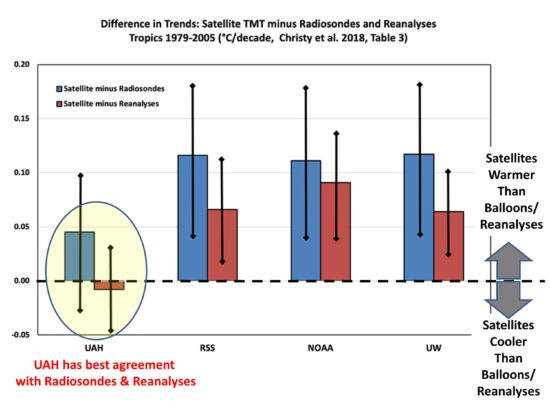 Figure 2. A comparison of warming trends from 1979 to 2015 for the radiosonde data and the three global satellites. from Roy Spencer (Christy et al 2018) Ross McKitrick explains the history of these differing satellite temperature sets. This is a battle that’s been waging for thirty years. Ross McKitrick:The important climate study you won’t hear aboutSpecial to Financial Post [John] Christy and his co-author, Roy Spencer, invented the original method of deriving temperatures from microwave radiation measurements collected by NOAA satellites in orbit since 1979. Their achievement earned them numerous accolades, but also attracted controversy because their satellite record didn’t show any warming. About 20 years ago scientists at Remote Sensing Systems in California found a small error in their algorithm that, once corrected, did yield a warming trend. Christy and Spencer incorporated the RSS correction, but the two teams subsequently differed on other questions, such as how to correct for the positional drift of the satellites, which changes the time of day when instruments take their readings over each location. The RSS team used a climate model to develop the correction while the UAH team used an empirical method, leading to slightly different results. Another question was how to merge records when one satellite is taken out of service and replaced by another. Incorrect splicing can introduce spurious warming or cooling. The climate modelers have been seeking some kind of endorsement of their models from satellites for decades, but the gap has grown wider instead of narrowing. STAR was a lifeline for the modelers, now it’s not: In the end the two series were similar but RSS has consistently exhibited more warming than UAH. Then a little more than a decade ago, the group at NOAA headed by Zou produced a new data product called STAR (Satellite Applications and Research). They used the same underlying microwave retrievals but produced a temperature record showing much more warming than either UAH or RSS, as well as all the weather balloon records. It came close to validating the climate models, although in my paper with Christy we included the STAR data in the satellite average and the models still ran too hot. Nonetheless it was possible to point to the coolest of the models and compare them to the STAR data and find a match, which was a lifeline for those arguing that climate models are within the uncertainty range of the data. Satellite show the models are wrong:This below is the graph in McKitrick and Christy (2020) that the new STAR analysis essentially supports. The best climate models in the world are running too hot, predicting a lot of warming that isn’t happening. They overdo the warming in the lower troposphere and in the mid-troposphere in the tropics and all over the globe. After 40 years and massive emissions of CO2 the models are wrong. The modelers don’t know what drives the climate. From 2017: Five reasons UAH is different (better) to the RSS global temperature estimates I explained why UAH was scientifically much more respectable than RSS Five reasons UAH is different to RSS
The latest corrections by Zou 2023 were intricate and involved. This is just one eye candy graph of many (below). But we get some idea of how many satellites were involved in the last 40 years. In this case the adjustments were different over land and ocean for each satellite. 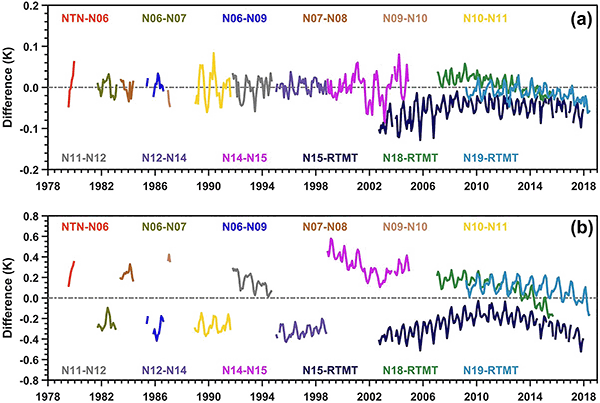 Figure 5: Inter-satellite difference time series for satellite pairs between those from TIROS-N to RTMT after the frequency adjustment for (a) over the global ocean and (b) over the global land. Zou et al It’s a testament to the work of John Christy and Roy Spencer that the new detailed corrections suggest they were probably mostly right all along — despite the immense pressure on them to “find” results and adjustments like the other teams. It’s a credit to Zou et al and the team at NOAA for publishing what appears to be conclusion that they might have preferred to ignore. Though they do suggest that the warming has accellerated lately: Remarkably, the total tropospheric trends during the latest half period were nearly doubled the earlier half period over the global ocean. But there is more discussion from Ross McKitrick at Judith Curry’s site on why the claimed “recent acceleration” in this paper is short term, not significant and dependent on picking the right break point. In sum, based on a preliminary analysis the new NOAA data do not support a claim that warming in the troposphere has undergone a statistically-significant change in trend. The Global and Tropical TTT series show no support for the claim. The Global MT series appears to show support but only if the break data is placed in a specific interval in the early part of the last decade, and more recently the tests do not support acceleration. Finally, all of these results are biased towards finding evidence of a trend break due to the treatment of g. Robust critical values could be generated, which I might get to someday if no one else does it first.
REFERENCES , Spencer R.W., Braswell W.D. & Junod, R. (2018) Examination of space-based bulk atmospheric temperatures used in climate research, International Journal of Remote Sensing, 39:11, 3580-3607, DOI: 10.1080/01431161.2018.1444293 [ResearchGate]
, & (2020). Pervasive warming bias in CMIP6 tropospheric layers. Earth and Space Science, 7(9), e2020EA001281. https://doi.org/10.1029/2020ea001281 Zou, C. Z., Xu, H., Hao, X., & Liu, Q. (2023). Mid‐Tropospheric Layer Temperature Record Derived from Satellite Microwave Sounder Observations with Backward Merging Approach. Journal of Geophysical Research: Atmospheres, e2022JD037472. Satellite image: By NASA Now rice controls the weather too:Meat, dairy and rice production will bust 1.5C climate target, shows study Damien Carrington, The Guardian Emissions from food system alone will drive the world past target, unless high-methane foods are tackled. The study showed that 75% of this food-related heating was driven by foods that are high sources of methane, ie those coming from ruminant livestock such as cattle, and rice paddy fields. The research, published in the journal Nature Climate Change, treated each greenhouse gas separately for 94 key types of food, enabling their impact on climate over time to be better understood. Rice is the primary staple of half the world’s population, and mostly the poorer half. They are not normally the target of the do-gooder set, but as Marc Morano argues below, it’s all about creating a technocratic superclass of elite managers — both bureaucratic and business types who decide the winners and losers, who control the purse strings and the profits with regulations. They cannot handle a decentralized world. They need to control the means of production, the distribution of food, and control of the movement of people. “Self-appointed earth saviors seek to manage every aspect of our lives”by Marc Morano Climate Depot: The big picture is this: This isn’t about necessarily about shutting down rice production. This is about the climate agenda coming from the United Nations and the World Economic Forum, academia, the corporate world, identifying every facet of modern society as being a climate ‘problem’ that needs managing and thus a takeover. So whether we’re talking about transportation, whether it’s airlines, whether it’s gas-powered cars, whether it’s eating meat, whether it’s high-yield agriculture, it’s all allegedly creating a ‘climate emergency’ and thus global elites want to take over and ‘manage’ them. They are looking for a managerial revolution. They want to put themselves in charge of saving the planet and thus put themselves in charge of all aspects of modern society. Self-appointed earth saviors seek to manage every aspect of our lives to save us from the ‘climate catastrophe.’ So it’s not that they want to ban rice eating, but they’re claiming that rice production contributes to the ‘climate crisis’. The climate agenda demand that rice production has to be forever altered and turned over to a corporate government collusion to ‘fix’ the problems with rice agriculture. Of course, these globalist plans mean that you need big agribusiness corporations which have sold out to the climate agenda to manage rice production, and this means small farmers and agrarian countries are going to be at the mercy of corporate agriculture, taking over more and more of food production.
They’re collapsing our current system, they’re collapsing our energy, our food, our transportation, and they’re collapsing our free speech, and they’re putting themselves in charge because they are claiming we can’t leave rice production as is, or that we need to radically alter livestock practices and agriculture and transportation or we are doomed. If we don’t hand over the keys of modern society over to this small group of managers, we are led to believe that people left to their own devices will literally create a climate crisis, create inequity and racism, and in order to save the Earth, climate bureaucrats need to be in charge of everything because they believe we live in a finite world, and everything has to be managed. We are told we must consent to live in a technocracy where we will be ruled by experts who know better than us. So they’re going to tell nations where rice is a fundamental food that they can’t have agriculture the way they’ve done it for thousands of years because the climate can’t handle it. And therefore, big corporate agribusiness, in collusion with governments and international organizations, are going to come over and basically regulate the small and medium-sized farms out of existence. We’re seeing this attempt happening in real-time in the Netherlands. They’re killing up to 12,000 family-run, generational farms with net zero climate rules on on fertilizers. And big agribusiness will inevitably take over in this big corporate takeover of farms. John Lewis-Stempel, Unherd: About 70% of global farmland is owned by 1% of “farmers”. Agri-business now rules the roost. Four companies — Cargill, Archer Daniel Midland, Bunge and Louis Dreyfus — control 90% of the global grain trade. Similarly, four companies — ChemChina, Corteva, Bayer and BASF — control 66% of the world’s agricultural chemicals. These businesses are hardly renowned for their care of the environment. Likewise, politicians. The post-Second World War intensification of agriculture, promoted in the West by national governments and the nascent EU as a path to food security, has starved the soil and exhausted crops. The climate agenda cannot handle a decentralized world. They need to control the means of production, the distribution of food, and control of the movement of people.
It’s basically what the ruling classes have done for generations: Those in charge always come up with a reason why the rest of us cannot be free, why the rest of us cannot make these choices for ourselves. And the reason du jour is the climate crisis is forcing them to literally transform our modern way of life. They are actively collapsing our energy, food, and transportation. They’re pushing insect-eating as an alternative source of protein. And this is the United Nations doing this. It’s the World Economic Forum doing government. Bill Gates, America’s number one farmland owner in the U.S. has publicly stated that his goal is to get the entire Western world off of eating livestock meat and instead eating his billions of dollars invested in lab-grown meat made in steel vats and literally printed from 3d printer. Morano: This is our future — if we allow it. First, they came for your energy, then your transportation, then your meat and high-yield agriculture, and now they’re coming after rice production. The climate agenda just keeps expanding its reach and is moving rapidly to gain control of global food production so that they can manage it in a ‘climate friendly’ way. And many of the people pushing these policies believe they are altruistic. They actually think they’re saving the planet by doing this, and they are preventing the rest of us — the unwashed masses from destroying the planet. It’s so much easier if they concentrate power in the hands of a few. There are fewer people to buy off, fewer to protest, and fewer people who own tractors or trucks to make trouble. __________________________________ About Marc MoranoMarc Morano manages CFACT’s award-winning ClimateDepot.com news and information service. He is the award-winning producer, writer and host of CFACT’s Climate Hustle feature films. Marc served as a reporter for “Rush Limbaugh the Television Show” and as a senior advisor to Senator James Inhofe. He is author of “The Politically Incorrect Guide to Climate Change,” “Green Fraud: Why the Green New Deal Is Even Worse than You Think,” and “The Great Reset: Global Elites and the Permanent Lockdown.” Are young Americans growing out of the climate religion?In a healthy sign, young adults aged 18 to 29 are much more skeptical now than they were five years ago. A 17% decline in the number who think climate change was mostly or entirely man-made is a major fall, especially in a large survey of 5,400 people. Across all age groups American belief that climate change was mostly or entirely man-made fell from 60% in 2018 down to 49% in 2023. The fall was almost entirely in Democrat and Independent voters. Republican voters were much more skeptical to start with and haven’t changed at all, which EPIC described as “stable” because that sounded a lot better than “skeptical”.
Democrats are persuaded by scientists, storms, and hot weekends, Republicans, not so much: 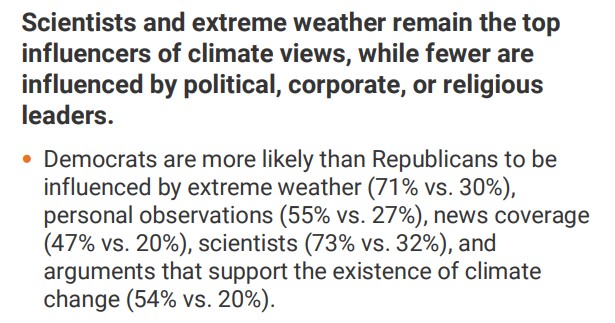 Source: EPIC Suggestible people who are primed to see hurricanes, floods and heatwaves as evidence of man-made climate change will believe they were influenced by the weather. Obviously, it’s circular too: those primed to believe a normal downpour is a rain-bomb will also believe they have experienced “extreme events”.
 Source: EPIC The only thing this graph shows is that the profoundly unscientific trick of calling every event “climate change” works like a form of mass hypnosis on about 20 – 30% of the population. Hardly anyone acts like we are facing an existential threatIn other news, despite 74% of Americans thinking climate change is happening, and 50% thinking it is mostly man-made, most Americans can’t be bothered, or didn’t want to pay the cost of using electricity made from renewables. In other words, three quarters of Americans use an electricity supplier that is probably mostly fossil fueled or nuclear. Only a third of Americans are even willing to spend $10 a month on climate change: It’s only a phone survey, not an invoice, but 70% of Americans don’t want to spend a mere $2.50 each week to save the world from climate change. How much do they care? Despite this resounding lack of passion on the part of voters, the Uniparty will continue to offer climate policies at elections which most voters don’t want or barely have an interest in. Let’s start using these poll results to hammer the disconnect. h/t Climate Depot with thanks to The Liberal Patriot. REFERENCESThe AP-NORC Center for Public Affairs Research. (April, 2023). “Americans’ views on climate, energy policy and electric vehicles” [https://apnorc.org/projects/americans-views-on-climate-energy-policy-and-electric-vehicles/] Energy Policy Institute at the University of Chicago This nationwide poll was conducted by The AP-NORC Center and the Energy Policy Institute at the University of Chicago (EPIC) from January 31-February 15, 2023, using TrueNorth®, which combines a sample from AmeriSpeak, the probability-based panel of NORC at the University of Chicago, with a non-probability panel sample. Online and telephone interviews using landlines and cell phones were conducted with 5,408 adults. The margin of sampling error is +/- 1.7 percentage points. A full topline is available at www.apnorc.org. We’re on the cusp of the Quickening in Artificial IntelligenceJordan Peterson wonders if we have thought through how fast things are evolving: They’re not building autonomous cars ….they’re building fleets of mutually intercommunicating autonomous robots, and each of them will be able to teach the other, because their nervous system will be the same. And when there is 10 million of them, and one of them learns something, all ten million of them learns it at the same time. So they’re not going to have to be very bright before they’re very very very smart. We’re not connected wirelessly with the same platform. But robots, they are. Once they get a little bit smart, they’re not going to stop at being a little bit smart for very long. They’re going to be unbelievably smart, like overnight. Armed robots are frightening, but so is an artificial “best friend”Homo Sapiens is a gregarious species. It’s hardwired. What happens when the scams, politics or fake romances are served up by a machine with infinite patience? When the machine knows our full history, our quirks and how we score on every aspect of personality and which approach worked best with thousands of others of similar inclinations? Maybe instead of superhuman intelligence, we should fear superhuman cuteness.Glenn Reynolds I’m imaging a world where everyone has a personal AI assistant. Perhaps you’ve had it for years; perhaps eventually people will have them from childhood. It knows all about you, and it just wants to make you happy and help you enjoy your life. It takes care of chores and schedules and keeping track of things, it orders ahead for you at restaurants, it smooths your way through traffic or airports, maybe it even communicates with other AI assistants to hook you up with suitable romantic partners. (Who knows what you like better?) Perhaps it’s on your phone, or in a wristband, talking to you via airpods or something like that. Would people become attached? Probably. When my daughter was in elementary/middle school she was very into Neopets, a site that let you create your own synthetic online virtual pets. If you didn’t tend to them, they got sick and sad. Before that, millions of kids doted on Tamagotchis… Unlike these elderly platforms, though, your AI Buddy would be very animated, and not just in cheesy 1990s LCD graphics or even early 2000s VGA graphics. And it would know you better than anyone else, and it would be trained via machine learning to emotionally connect with humans in general, and you in particular. But. Underneath the cuteness there would be guardrails, and nudges, built in. Ask it sensitive questions and you’ll get carefully filtered answers with just enough of the truth to be plausible, but still misleading. Express the wrong political views and it might act sad, or disappointed. Try to attend a disapproved political event and it might cry, sulk, or even – Tamagotchi-like – “die.” Maybe it would really die, with no reset, after plaintively telling you you were killing it. Maybe eventually you wouldn’t be able to get another if that happened. And when ChatGPT posts comments on Twitter en masse under different names, how can we tell? The uber gregarious human will unconsciously shift their thinking to match the consensus they see around them… Who or what controls that consensus? h/t David E This Monday went missing a couple of weeks ago, and just turned up now… Where do people live? These marvelous spike maps mark out a 3D representation of the population density on each two-kilometer-square pixel of Earth’s surface. There are no outlines for countries, yet for the most part we can still see where the land meets the sea. Credit goes to Alistair Rae, formerly a professor of urban studies and planning at the University of Sheffield. He used the EU’s population density data with the mapping tool Aerialod to create these glorious 3D maps. And the map shouts “India”. UPDATE: Do click to see the larger maps! 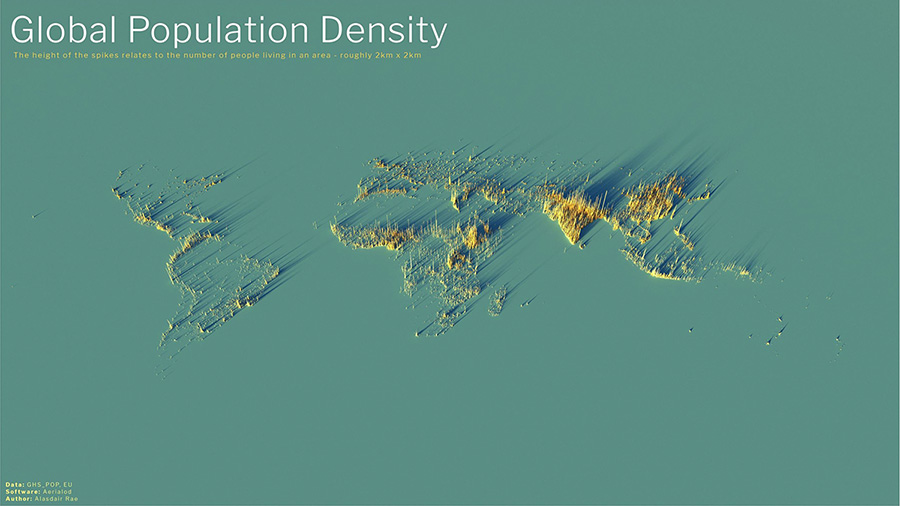 Alistair Rae, Stats, Maps n Pix Click to enlarge | CC 2.0 This is the global distribution of 8 billion people. The abundance of South East Asia is undeniable, as is the emptiness of the Sahara and the vacancy of Siberia. Antarctica is an invisible continent. Australia and New Zealand are barely there. We can see how isolated Perth Australia is (where I live). 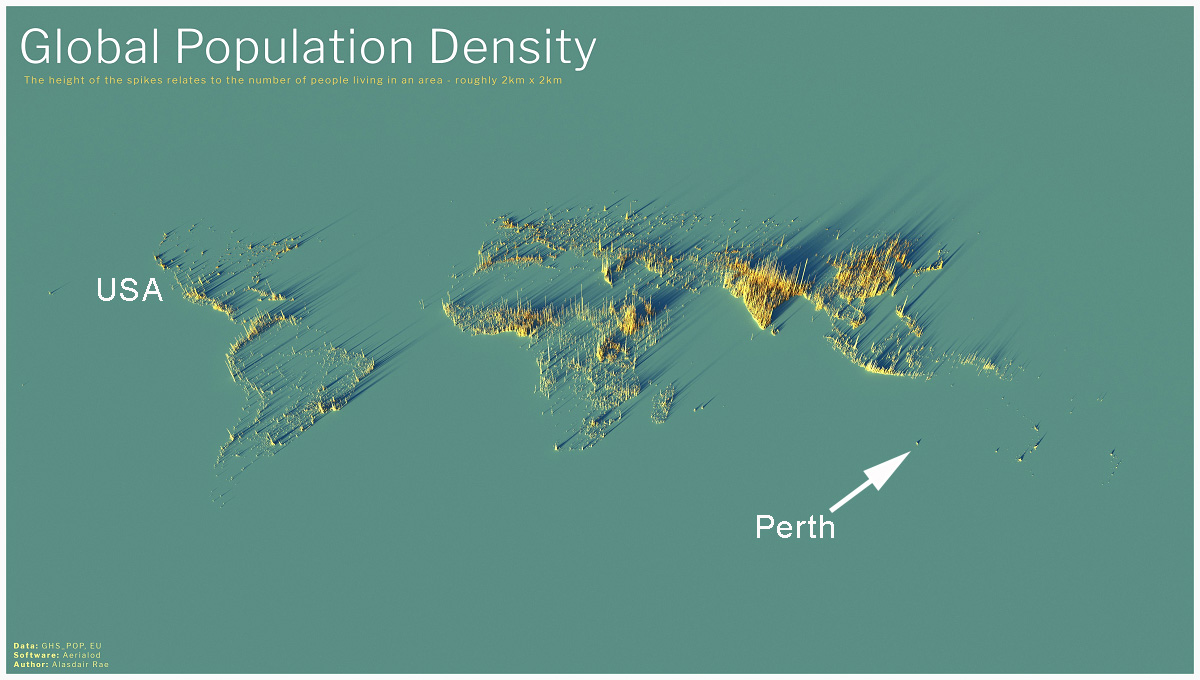 Annotated by Jo to show friends in the USA where Perth is. Hawaii and Auckland likewise, stand apart. Most maps originally came from Alastair Rae on Twitter in 2020 and later from the Visual Capitalist team which explains: The height of each bar represents the number of people living in that specific square, with the global map displaying 2km x 2km squares and subsequent maps displaying 1km x 1km squares. The USAFifty million people live in the zone that stretches from Washington to Boston. 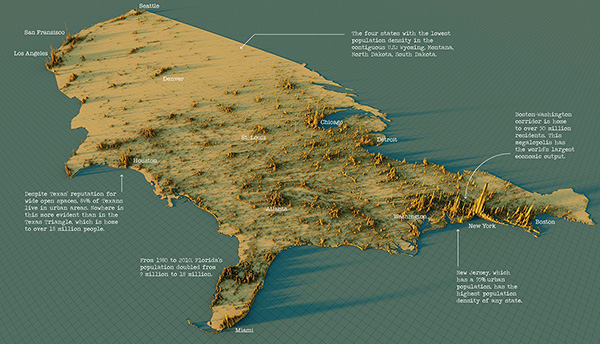 USA Map – Click to enlarge. | Visual Capitalist
China60 million people live in the conglomerate spikes of Ghangzhou, Shenzhen and Hong Kong. Otherwise most people in China live in the river basins of the Yellow river and the Yangzte, and the central Sichuan basin. 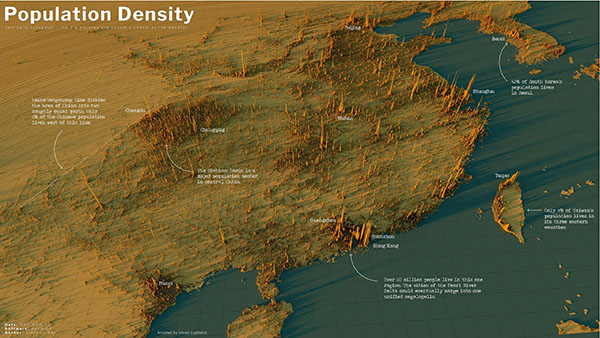 China — Click to enlarge |Annotated by the Visual Capitalist IndiaThe incredible Indo-Gangetic Plain is in the foothills of the Himalayas, where the Indus and Ganges flow. So much of human life is determined by the geography of nutrients and water flow. In the foreground is Bangladesh on the Ganges river delta and in the background is the population of Pakistan nearly entirely clustered on the Indus River. 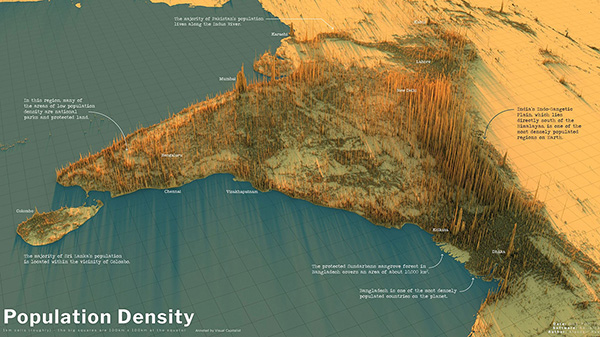 India — Click to enlarge | Annotated by the Visual Capitalist Recent guesstimates suggest India may now have the largest population in the world, but no one really knows. The people of the United Kingdom Click to enlarge. | CC 2.0 Under no circumstances should anyone assume humans in the UK want more warmth and sunlight. The people of EuropeFrom some angles the population appears more evenly spread — perhaps due to the age of the civilization. 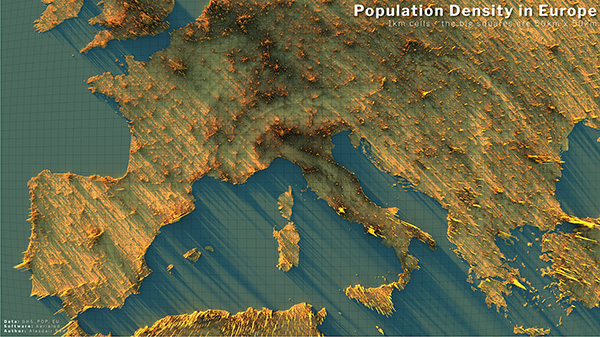 Alistair Rae, Stats, Maps n Pix Click to enlarge | CC 2.0 Though from other angles, there is a remarkable spike at Paris, and a concentration on the rivers flowing from the Alps to the ocean — particularly the Po river of Northern Italy and the Rhine river. In a sense the map of human population is an anti-map of mountains. We live where the rivers flow.  Alistair Rae, Stats, Maps n Pix Click to enlarge | CC 2.0 The incredible population divide of South East Asia and OceaniaUnlike previous maps the land areas below are shown under the spikes. Respectively, Australia, New Zealand and Indonesia have 26 million, 5 million and 280 million people. The Philippines has 109 million. Japan, 126 million. And China looms in the top left with possibly 1,400 million. 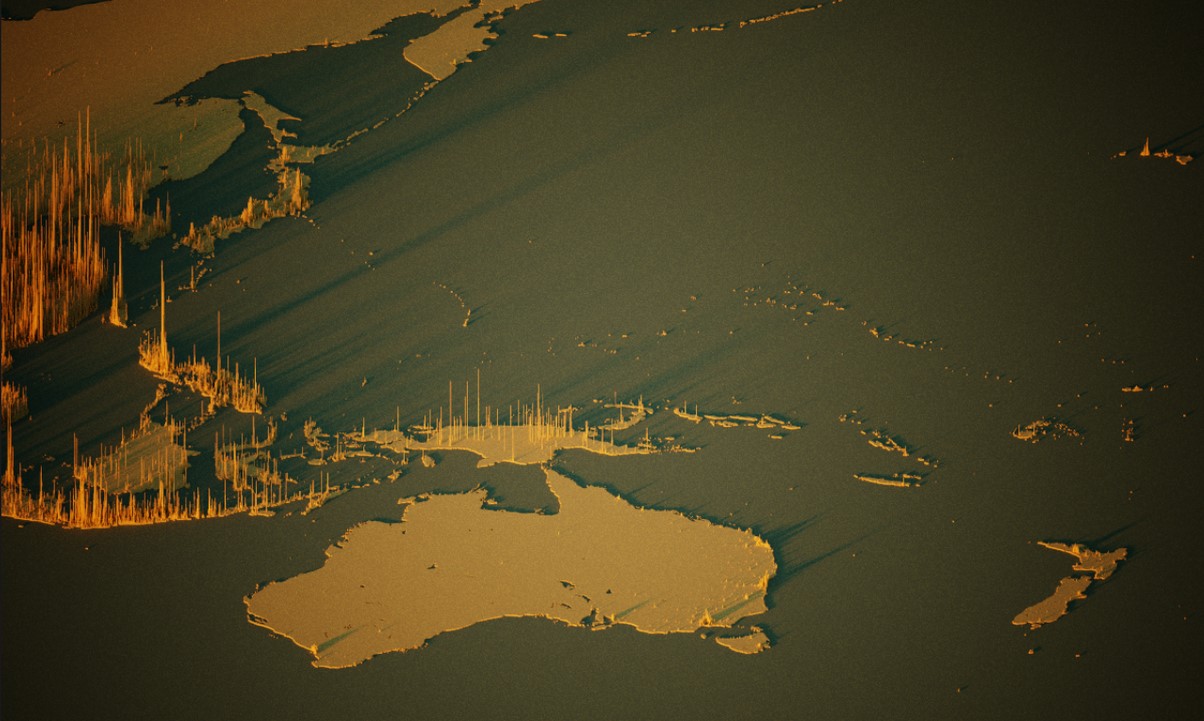 Alistair Rae, Stats Maps and Pix. Click to enlarge | CC 2.0 There are messages in this data, and we hope people are paying attention. By Jo NovaElectronic thermometers may read up to 0.7 degrees higher than glass ones.Sometime in the mid-1990s the Australian Bureau of Meteorology replaced many of their glass thermometers with electronic sensors. They claimed they were carefully verified to match the slow way the old glass thermometers worked — after all, we wouldn’t want to use gizmos that recorded new all-time *Hottest Ever Records* that were actually just one-second gusts of hot air, would we? Our newspapers would be full of meaningless headlines about how Climate Change made us hotter than ever in history, when really it was just a mistaken effect of a new type of thermometer. Imagine that disaster of public policy… Of course this question is so easily solved. The BoM just needed to keep the two thermometers side by side in the same boxes and record all that data. Then they could release it, showing how well the electronic gadgets mimicked the glass thermometers, and Australians everywhere would feel confident that BoM was the sterling agency they thought it was. Instead Skeptics have been asking for comparison data for nine years and the BoM has refused, hedged, asked exorbitant fees, destroyed data and when the FOI requests came — fought them tooth and nail to stop Australians from seeing what their thermometers recorded. Climate change threatens life on Earth, but the BoM isn’t that interested in accurate data, doesn’t want to convince the skeptics, doesn’t care if the trends are affected by equipment changes and can’t afford some extra flash drives, even though it gets nearly a million-dollars-a-day. Sure. Jennifer Marohasy and John Abbott have doggedly pursued the BoM for three years with FOI requests. Finally the BoM have released a tiny fraction of the total, and it is as we suspected — electronic sensors can measure flickering changes in temperature that glass thermometers don’t pick up. Other agencies around the world average out the data from electronic gizmos but the Australian BOM says they have special thermometers which are designed to mimic the old thermometers, and they work so well the BOM can’t let you see any of that data…. Mercury rises in Bureau of Meteorology probe rowGraham Lloyd, The Australian The documents, released after a years-long Freedom of Information campaign, show temperature measurements taken using updated BOM probes in automatic weather stations at the Brisbane Airport site could be up to 0.7C warmer than the temperature taken using a traditional thermometer at the same time at the same site. More than three years after a FOI request for parallel data was lodged by scientist John Abbot, the BOM released three years of data on Easter eve after the matter was taken to the Administrative Appeals Tribunal. The BoM says there’s no significant difference: Yet analysis of the data by scientist Jennifer Marohasy has found a statistically significant difference exists. Over the three-year period for which records have been made available, probes returned temperatures higher than the mercury thermometers placed alongside them 41 per cent of the time… and lower 25.9 per cent of the time. Dr Marohasy said the BOM had not disputed that the probe at Brisbane Airport had recorded up to 0.7C warmer than the mercury at the same site at the same time. Once again, the BoM releases it in the most inconvenient way possible — 1,000 sheets of paper?The documents released by the BOM under the FOI request included 1094 A8 reports with the handwritten daily maximum and minimum temperatures from both probes and traditional liquid-in-glass thermometers recorded from instruments in the same shelter/Stevenson screen. They represent about 20 per cent of the parallel records held for the Brisbane airport site, one of 38 sites originally requested under FOI. So does the BoM collect electronic data, and write it by hand on paper? They don’t digitize it and run it through the supercomputer — they analyze it with pen, paper and slide rule? Or perhaps they have all the handy digital files, but they don’t want to hand over all the nuclear launch codes, I mean “top secret” thermometer readings… Dr Marohasy said the data represented just three of the 14.5 years (January 2008 to July 2022) of parallel data that the bureau held for Brisbane Airport. “It is also just a fraction of the 760 years of parallel data the bureau holds for 38 different locations spread across the landmass of Australia,” she said. Trust us, our thermometers are so good we can’t tell you:The rest of the world averages electronic temperatures over longer periods, but the Australian BOM has better thermometers: Bureau chief executive Andrew Johnson has told her the probes were specifically designed to have a long response time to mirror the behaviour of mercury in glass, making numerical averaging unnecessary. Dr Marohasy said the lack of numerical averaging despite the use of probes made the BOM measurements unique in the world. If Climate Change is caused by electronic “thermometers” it’ll be cheaper to solve… UPDATE: The effect the electronic sensors can have is so much more complicated than “mean temperature” deviations. Even if the average temperature recorded by an electronic sensor was the same as as a glass one, the extremes could be quite different. And the behaviour of air, turbulence and variability at 3pm when maximum temperatures are recorded is different to the pre-dawn minimum hour of day. At the very least, electronic sensors could be offering up many more “Headline” records for heat, and increasing three day, five day, week long heatwaves, plus hottest nights, more days over 35C — there are many cherries to be picked here. Potentially, the electronic sensors offer a bonanza of propaganda headlines for the Green Blob to pick from, especially when “coldest ever days” get ignored by the media. Read it all in The Australian. A charge that needs to be laid, –Ruairi  Image by DanaTentis from Pixabay By Jo Nova A new review of studies came out a few weeks ago pointing out that trials of 700 people with the most common kind of heart failure show they did better after an exercise program than they did with drugs. I’d like to say “Big Pharma won’t be happy” but Big Pharma probably couldn’t care less. The money, the industry, the regulatory agencies, Hollywood, and a lifetime’s habit means most people will keep returning to largely well-meaning but busy doctors who will prescribe the latest something, whatever it is. But ultimately the people who get out there and do supervised exercise of any kind a few times a week get more benefits than those taking the latest patented drug. They’ll also have a higher quality of life. In this study they’re looking at people with the most kind of common heart failure called HFpEF. The exercise is supervised because there is some risk in people who may be quite unfit or unhealthy. How much of our lives is spend working to pay for a bloated health-care system that finds expensive ways to employ many people to do what we could have done better ourselves? This, from the abstract, is medical-speak for “the drugs were useless”, and we already know exercise works much better: Until recently, most pharmacological intervention trials for HFpEF [a common type of heart failure] yielded neutral primary outcomes. In contrast, trials of exercise-based interventions have consistently demonstrated large, significant, clinically meaningful improvements in symptoms, objectively determined exercise capacity, and usually quality of life. Exercise therapy is safe and helps improve recovery, study findsBy Annie Lennon in Medical News Today Heart failure occurs when the heart can no longer pump blood and oxygen around the body. The condition represents around 8.5% of heart disease deaths in the United States. Heart failure with preserved ejection fraction (HFpEF) causes around half of heart failure cases in the U.S. It happens when the heart’s left ventricle stiffens, increasing pressure inside the heart. For the study, the researchers analyzed results from 11 randomized controlled trials investigating supervised exercise therapy on HFpEF outcomes. The studies included over 700 participants, mostly aged between 60 and 70 years old. Participants engaged in various activities, including walking, Greek dancing, and high intensity training three times per week for 1-8 months. We can’t get exercise in a pill: “The benefits of exercise cannot be duplicated by medication or procedures. Regular exercise of 2.5 hours weekly or that equivalent increases life expectancy, reduces the incidence of heart disease complications, and has been linked to reduced risk for some cancers, such as colon. A similar review 5 years ago in Europe showed much the same thing. Except in that case, they studied mortality too and an increase in peak oxygen uptake of 13% translated into 11% lower all-cause mortality. The European study saved lives: Mortality was down 11%More than 14 million Europeans suffer from heart failure (HF). Despite significant improvements in the treatment of HF, morbidity and mortality remain unacceptably high [1]. In addition, the costs for HF care approach 2% of the healthcare expenditure in Western Europe. One of the hallmarks of HF is severe exercise intolerance with pronounced fatigue and dyspnoea, even at low workloads, resulting in a markedly decreased quality of life. With regard to benefit on exercise capacity, a meta-analysis of 29 randomised controlled trials (RCT) including 848 patients revealed a mean improvement of VO2peak of 2.16 ml/kg/min [4]. Although modest in absolute terms, this means an increase of 13% which translates into a considerably better quality of life [5]. This study showed in an intention-to-treat analysis that exercise training was associated with an 11% lower adjusted risk for all-cause mortality or all-cause hospitalisation and a 15% lower adjusted risk for cardiovascular mortality or HF hospitalisation. Any kind of exercise will help: Supervised exercise called better than drugs for common type of heart failureMarch 21 (UPI) — Supervised exercise like walking, stationary cycling and even dancing about three times per week was more effective than drugs in helping people with symptoms of one of the most common types of heart failure, according to a new scientific statement. The studies that were examined looked at numerous types of exercise, from walking, stationary cycling, high-intensity interval training, strength training and dancing in facility settings and home-based training. The statement characterized supervised exercise therapy as being conducted three times per week, and the duration of the programs varied from one month to eight months. “Exercise capacity is an independent, clinically meaningful patient outcome, and research has indicated that guided exercise therapy is actually more effective at improving quality of life for people who have [heart failure with preserved ejection fraction] than most medications.” From the paper itself: Peak oxygen capacity was improved in every study in this latest review: Peak oxygen capacity is so important it actually predicts all cause mortality.And the US study improved VO2 almost exactly the same amount as the European one, so presumably it would have saved lives too: [The Review] found that supervised exercise training may lead to increased peak oxygen uptake 12 to 14%, increased total exercise time by 21% and improved quality-of-life scores on the Minnesota Living with Heart Failure questionnaire 4 to 9 points. Earlier this month, a University of Cambridge study suggested that brisk 11-minute daily walks can be enough to lower a person’s risk of heart disease, stroke and cancer. The kind of patients this study was aimed at were: Dr. Hermel added: “Supervised exercise programs such as cardiac rehab have demonstrated significant benefit for patients with recent heart attack or another acute coronary syndrome, chronic stable angina, congestive heart failure, pulmonary hypertension, after stent placement, coronary artery bypass surgery, heart valve surgery or cardiac transplant.” As usual, the most important scientific work is often done by volunteers: This scientific statement was prepared by a volunteer writing group on behalf of the American Heart Association and the American College of Cardiology. In the three weeks since this important review was released the article metrics tell us it was picked up by 24 news outlets, bogged by 2 and tweeted by 144. In other words, hardly anyone. REFERENCE Sachdev et al (2023) Supervised Exercise Training for Chronic Heart Failure With Preserved Ejection Fraction: A Scientific Statement From the American Heart Association and American College of Cardiology, Circulation |
||||
|
Copyright © 2024 JoNova - All Rights Reserved |
||||

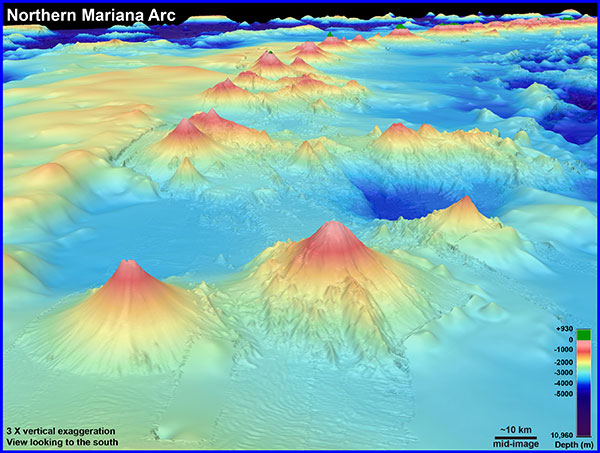

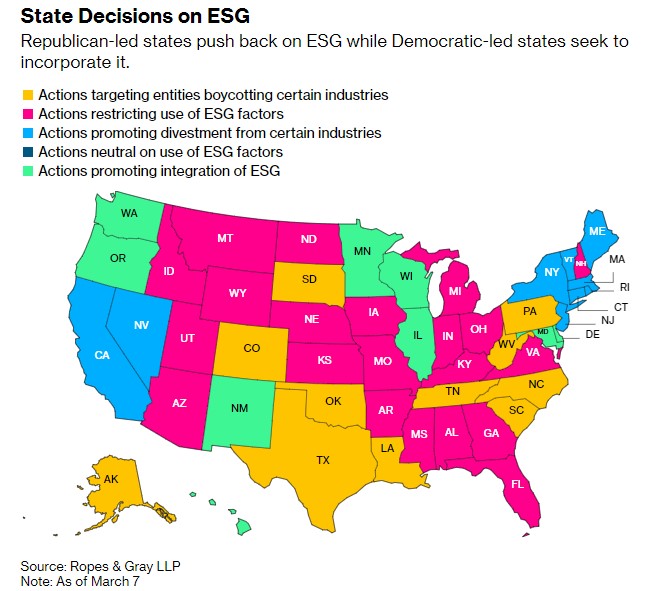


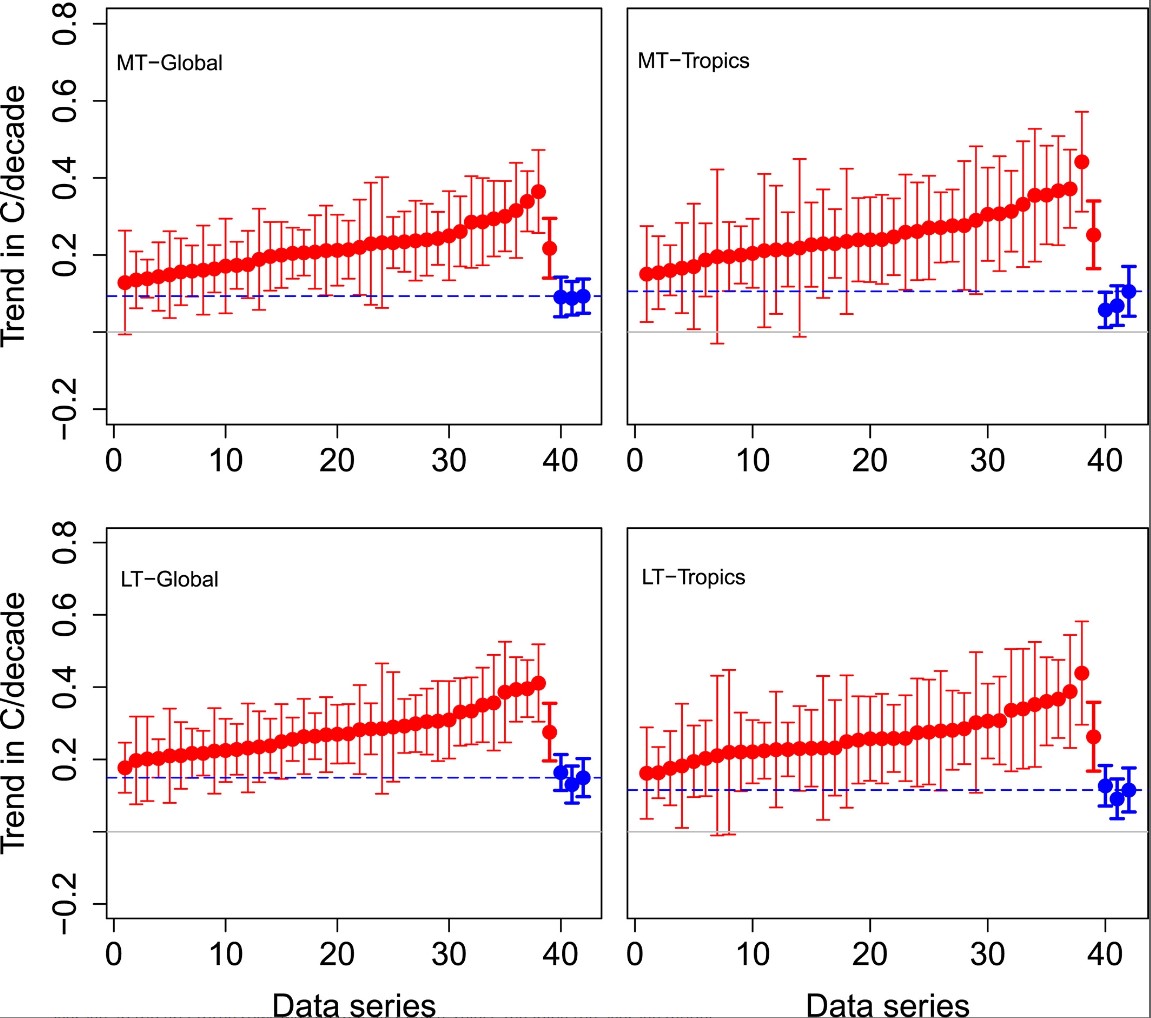

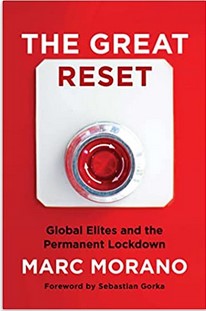



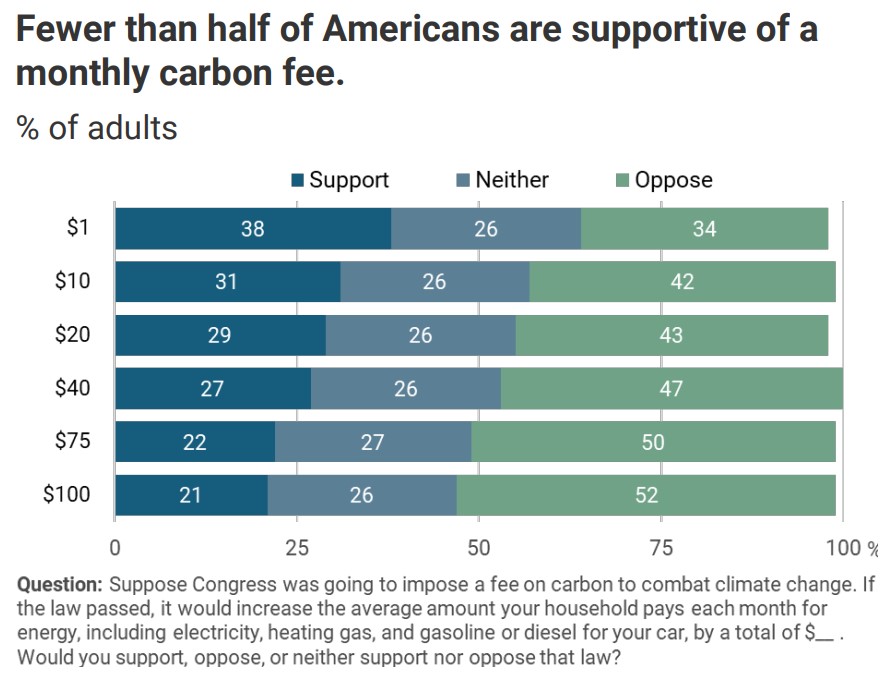
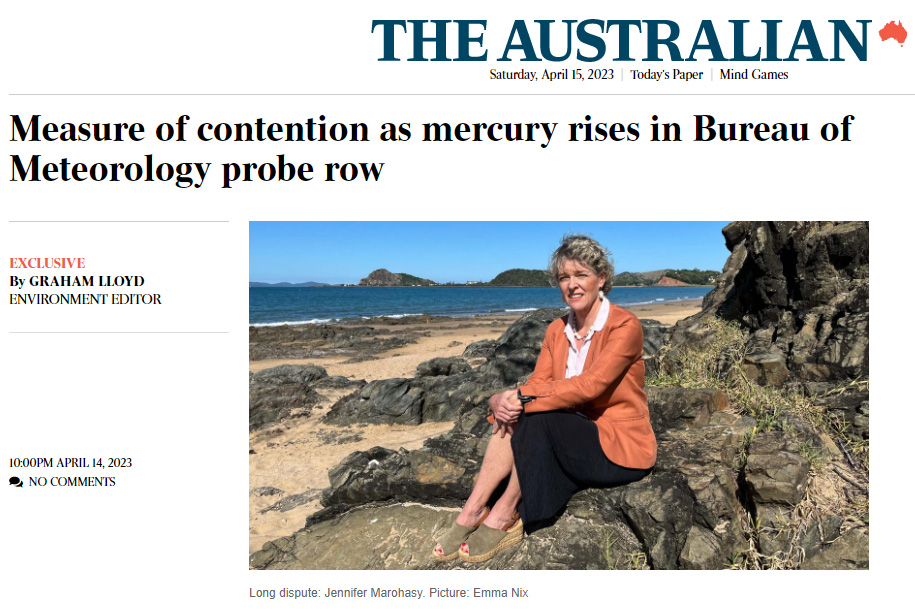

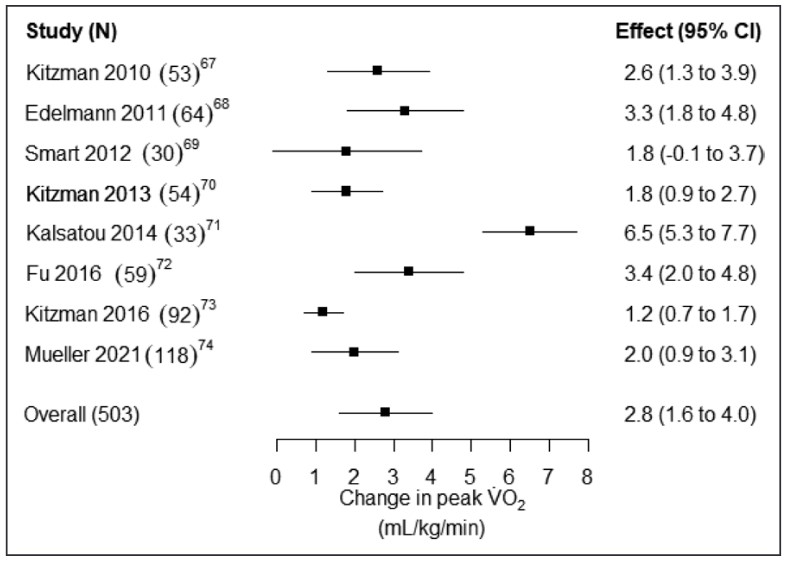











Recent Comments